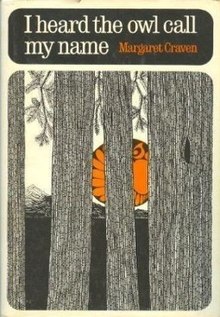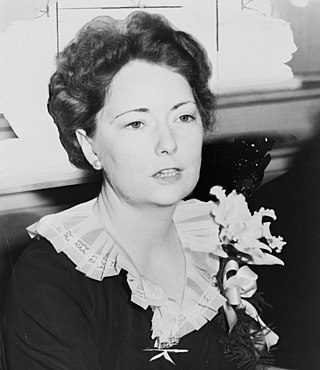
Margaret Munnerlyn Mitchell was an American novelist and journalist. Mitchell wrote only one novel, published during her lifetime, the American Civil War-era novel Gone with the Wind, for which she won the National Book Award for Fiction for Most Distinguished Novel of 1936 and the Pulitzer Prize for Fiction in 1937. Long after her death, a collection of Mitchell's girlhood writings and a novella she wrote as a teenager, titled Lost Laysen, were published. A collection of newspaper articles written by Mitchell for The Atlanta Journal was republished in book form.
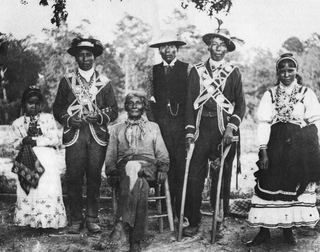
Choctaw mythology is part of the culture of the Choctaw, a Native American tribe originally occupying a large territory in the present-day Southeastern United States: much of the states of Mississippi, Alabama, and Louisiana. In the 19th century, the Choctaw were known to European Americans as one of the "Five Civilized Tribes" even though controversy surrounds their removal.
This article is about the spiritual beliefs, histories and practices in Kwakwaka'wakw mythology. The Kwakwaka'wakw are a group of Indigenous nations, numbering about 5,500, who live in the central coast of British Columbia on northern Vancouver Island and the mainland. Kwakwaka'wakw translates into "Kwak'wala-speaking tribes." However, the individual tribes are single autonomous nations and do not view themselves collectively as one group.
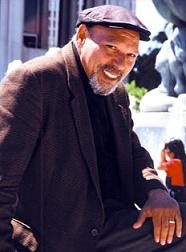
August Wilson was an American playwright. He has been referred to as the "theater's poet of Black America". He is best known for a series of 10 plays, collectively called The Pittsburgh Cycle, which chronicle the experiences and heritage of the African-American community in the 20th century. Plays in the series include Fences (1987) and The Piano Lesson (1990), both of which won the Pulitzer Prize for Drama, as well as Ma Rainey's Black Bottom (1984) and Joe Turner's Come and Gone (1988). In 2006, Wilson was inducted into the American Theater Hall of Fame.

The Kwakwa̱ka̱ʼwakw, also known as the Kwakiutl, are one of the indigenous peoples of the Pacific Northwest Coast. Their current population, according to a 2016 census, is 3,665. Most live in their traditional territory on northern Vancouver Island, nearby smaller islands including the Discovery Islands, and the adjacent British Columbia mainland. Some also live outside their homelands in urban areas such as Victoria and Vancouver. They are politically organized into 13 band governments.

Freddy Krueger is a fictional character and the primary antagonist in the A Nightmare on Elm Street film series. He was created by Wes Craven and made his debut in Craven's A Nightmare on Elm Street (1984) as the malevolent spirit of a child killer who had been burned to death by his victims' parents after evading prison. Krueger goes on to murder his victims in their dreams, causing their deaths in the real world as well. In the dream world, he is a powerful force and seemingly invulnerable. However, whenever Freddy is pulled back into the real world, he has normal human vulnerabilities and can be destroyed. He is commonly identified by his burned, disfigured face, dirty red-and-green-striped sweater and brown fedora, and trademark metal-clawed, brown leather, right hand glove. This glove was the product of Krueger's own imagination, having welded the blades himself before using it to murder many of his victims, both in the real and dream worlds. Over the course of the film series, Freddy has battled several reoccurring survivors including Nancy Thompson and Alice Johnson. The character was consistently portrayed by Robert Englund in the original film series as well as in the television spin-off Freddy's Nightmares.
Rorschach is a fictional antihero in the graphic novel limited series Watchmen, published by DC Comics in 1986. Rorschach was created by writer Alan Moore with artist Dave Gibbons; as with most of the main characters in the series, he was an analogue for a Charlton Comics character, in this case Steve Ditko's the Question. Moore also modeled Rorschach on Mr. A, another Steve Ditko creation on whom the Question was originally based.
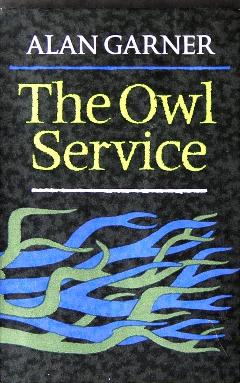
The Owl Service is a low fantasy novel for young adults by Alan Garner, published by Collins in 1967. Set in modern Wales, it is an adaptation of the story of the mythical Welsh woman Blodeuwedd, an "expression of the myth" in the author's words.

Deadly Friend is a 1986 American science fiction horror film directed by Wes Craven, and starring Matthew Laborteaux, Kristy Swanson, Michael Sharrett, Anne Twomey, Richard Marcus, and Anne Ramsey. Its plot follows a teenage computer prodigy who implants a robot's processor into the brain of his teenage neighbor after she is pronounced brain dead; the experiment proves successful, but she swiftly begins a killing spree in their neighborhood. It is based on the 1985 novel Friend by Diana Henstell, which was adapted for the screen by Bruce Joel Rubin.

Charles Gore was a Church of England bishop, first of Worcester, then Birmingham, and finally of Oxford. He was one of the most influential Anglican theologians of the 19th century, helping reconcile the church to some aspects of biblical criticism and scientific discovery, while remaining Catholic in his interpretation of the faith and sacraments. Also known for his social action, Gore became an Anglican bishop and founded the monastic Community of the Resurrection as well as co-founded the Christian Social Union. He was the chaplain to Queen Victoria and King Edward VII.

Margaret Craven was an American writer.
Pope John IV of Alexandria was the 48th Pope of Alexandria and Patriarch of the See of St. Mark from 777 to 799.

John Leonard was an American literary, television, film, and cultural critic.
Francis Gladden Bishop was a minor leader in the Latter Day Saint movement after the 1844 succession crisis. Bishop claimed to be the rightful successor to Joseph Smith; from the 1850s until his death, Bishop led a succession of small groups of Latter Day Saints and converts. His followings have been identified informally by later writers as the Gladdenites and the Church of Jesus Christ of Latter Day Saints (Gladdenite), though the name of a late following is formally The Church of Jesus Christ of the New Jerusalem. In the 1850s, many of Bishop's followers abandoned him and joined the movement that would later become the Church of Christ.
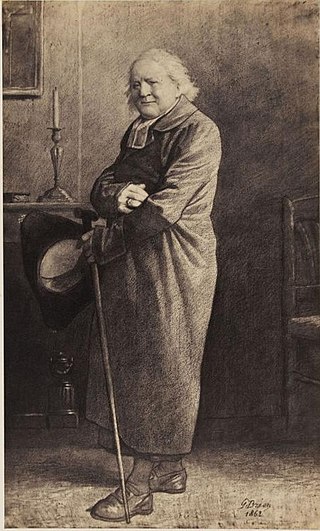
Bishop Charles-François-Bienvenu Myriel, referred to as Bishop Myriel or Monseigneur Bienvenu, is a fictional character in Victor Hugo's 1862 novel Les Misérables. Myriel is the Bishop of Digne in southeastern France.
Kingcome, also known as Okwunalis or Ukwana'lis is an unincorporated settlement in the Kingcome Inlet area of the Central Coast of British Columbia, Canada, located a few miles up the Kingcome River from the head of the inlet. Quaee Indian Reserve No. 7 is the Indian reserve containing the village.
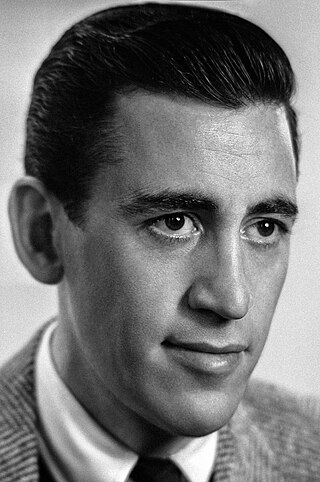
Jerome David Salinger was an American author best known for his 1951 novel The Catcher in the Rye. Salinger published several short stories in Story magazine in 1940, before serving in World War II. In 1948, his critically acclaimed story "A Perfect Day for Bananafish" appeared in The New Yorker, which published much of his later work.

Death is frequently imagined as a personified force. In some mythologies, a character known as the Grim Reaper causes the victim's death by coming to collect that person's soul. Other beliefs hold that the spectre of death is only a psychopomp, a benevolent figure who serves to gently sever the last ties between the soul and the body, and to guide the deceased to the afterlife, without having any control over when or how the victim dies. Death is most often personified in male form, although in certain cultures death is perceived as female. Death is also portrayed as one of the Four Horsemen of the Apocalypse. Most claims of its appearance occur in states of near-death.
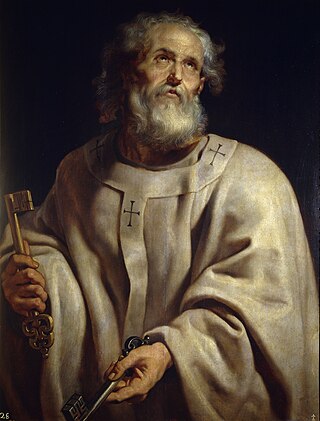
Saint Peter, also known as Peter the Apostle, Simon Peter, Simeon, Simon, or Cephas, was one of the Twelve Apostles of Jesus Christ and one of the first leaders of the early Christian Church. He appears repeatedly and prominently in all four New Testament gospels as well as the Acts of the Apostles. Catholic tradition accredits Peter as the first bishop of Rome—or pope—and also as the first bishop of Antioch.
Bernardine Anna Livia Mary Bishop was an English novelist, teacher and psychotherapist. Her first novel, Perspectives, was published by Hutchinson in 1961. During a half-century break between publishing her first two novels and her third, the 2013 Costa prize-nominated Unexpected Lessons In Love, she brought up a family, taught, and practised as a psychotherapist.
